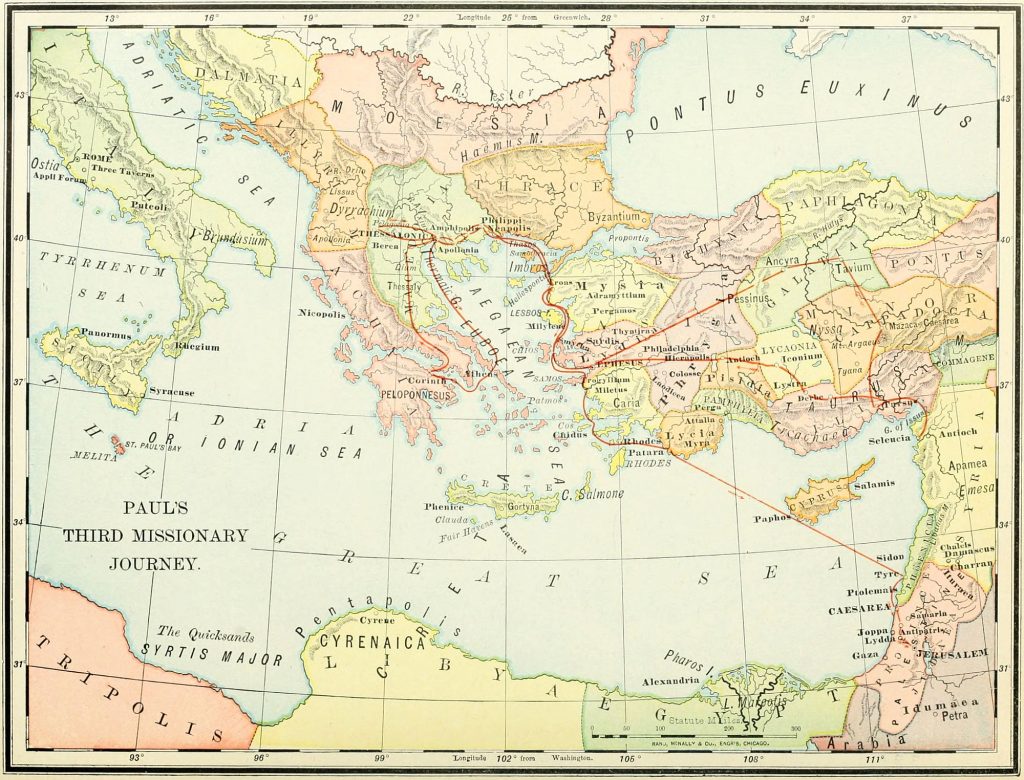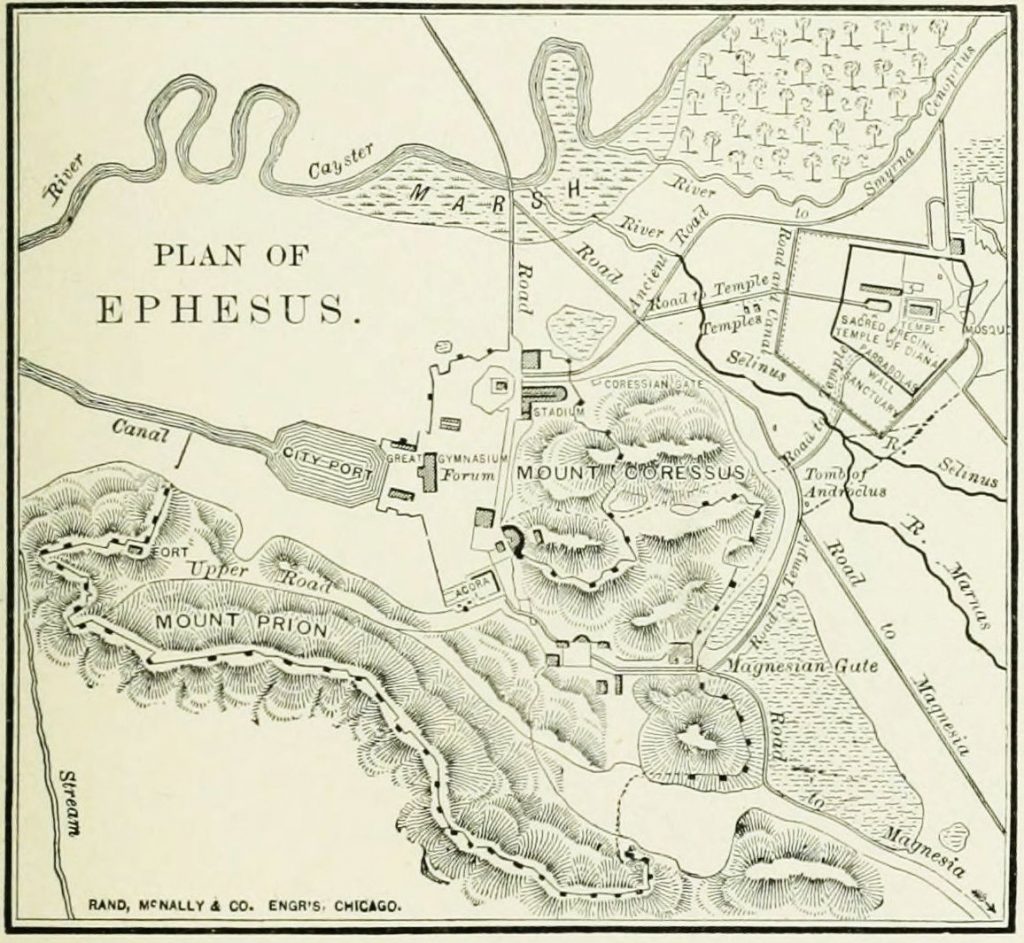
Apostle Paul’s third missionary journey ( Acts 18:23 to Acts 21:16), beginning at Antioch, led him as far west as Corinth, and then as far east as Jerusalem. It probably occupied about four years, from A.D. 54 to 58. great Epistles to the Galatians, Corinthians and Romans where written during this period.
The whole journey may be subdivided into two stages: I. The Outward Journey, from Antioch to Corinth, including seven stations. II. The Return Journey, from Corinth to Jerusalem, with fifteen stations. More than half of this period was spent at Ephesus, where Paul preached for nearly three years.

I. The Outward Journey. (Acts 18:23-20:3)
1. We note Antioch, the starting point for each of Paul’s three missionary journeys.
2. His westward course lay through Galatia (Acts 18:23), where he visited the churches planted upon his former tour. But as before, this may refer to the part of Galatia embraced in Lycaonia; and we have thus indicated upon the map by a dotted line.
3. Still journeying westward toward the coast, Paul passed through Phrygia (Acts 18:23). No events of this part of the journey are related.
4. He came from the highlands of the interior to Ephesus, where he had touched on his previous journey, and was now to remain longer than at any other place during his active ministry. (Acts 19:1-20:1) Ephesus was the metropolis of Proconsular Asia, and may be regarded as the third capital of Christianity, as Jerusalem had been its birthplace, and Antioch the center of its foreign missions. It stood a mile from the Aegean Sea, fronting an artificial harbor, in which met the ships of all lands, and above which rose the Temple of Artemis (Diana), celebrated as the most magnificent building in Asia Minor, though the image which it enshrined was only a shapeless block. Its population was principally Greek, though with a large Oriental mixture. Here a preparation for Paul’s labor had been made by Apollos, who had instructed a small company of Jews up to the twilight of John the Baptist’s teachings concerning the Messiah. From Paul’s friends, Aquila and Priscilla, he had learned the gospel of Christ; and, just before the apostle’s arrival, had gone to Corinth. For three months Paul labored in the synagogue with the Jews and inquiring Gentiles; but, when the Jewish opposition endangered the work, he took the step (at this time first in the history of Christianity) of calling the believers in Christ out of the synagogue. Paul remained at Ephesus in all more than two years, working at his trade through the week, while preaching on the Jewish Sabbath. Through his endeavors most of “the Seven Churches,” addressed long afterward by John, were founded at this time. Near the close of his stay at Ephesus, Paul wrote the First Epistle to the Corinthians.

5. The next stopping place of the apostle was at Troas. (2 Cor. 2:12-13) This is mentioned, not in the Acts, but in the Epistle written soon afterward. Here he had expected to meet his companion Titus, with news from the church at Corinth. While waiting, he found an opportunity for preaching, and success in winning souls. But, as the expected tidings did not come, Paul again took ship, and sailed once more from Asia to Europe.
6. His next station is named as Macedonia (Acts 20:2); but it may be inferred that he visited Philippi, Thessalonica and Berea, the places of former labors, already described in the account of the second journey. Perhaps it was at this time that he journeyed “round about unto Illyricum,” which was a province on the Adriatic Sea, west of Macedonia. (Rom 15:19) While in Macedonia, perhaps at Philippi, Paul wrote the Second Epistle to the Corinthians.
7. The last place in Paul’s outward journey is mentioned as Greece, the province elsewhere called Achaia. (Acts 20:2-3, 18:27) His principal errand was to Corinth, where troubles in the church required his attention. While here he wrote the Epistle to the Galatians, and his great statement of Christian doctrine, the Epistle to the Romans.
II. The Return Journey. (Acts 20:6-21:6.)
This was undertaken with the desire of reaching Jerusalem in time for the Feast of Pentecost, A.D. 58. For some reason, probably on account of a Jewish plot to murder him, Paul did not take the direct route, but went around the Aegean Sea by way of Philippi and Troas, and was accompanied by a number of friends.
1. From Corinth, Paul and his friends journeyed overland, through Greece and Macedonia, to Philippi (Acts 20:3-6), a place now visited for the third time. Here Paul was rejoined by Luke the Evangelist, who henceforth shared his dangers to the end of his life.
2. Most of Paul’s company sailed from Philippi across the Aegean Sea to Troas, in advance of the apostle, but were soon followed by Paul and Luke. (Acts 20:5-13.) At Troas they remained for a week with the church; and here Eutychus was restored to life by the apostle.
3. From Philippi, most of the company set sail for Palestine, but Paul went on foot as far as Assos, where he was taken on board. (Acts 20:13-14.) This place was situated 19 miles from Troas, and is now marked by extensive ruins.
4. Mitylene. This was on the island of Lesbos, famed as the home of Sappho, the Greek poetess. Here they anchored for the night, as the channel was not easy to follow among the islands. (Acts 20:14.) This and the succeeding stations in the Aegean Sea may be noticed on the map of the islands and coasts of Asia Minor.
5. Chios. (Acts 20:15.) This is an island 32 miles long, and 5 miles from Asia; said to have been the birthplace of Homer; and now called Scio. Here Paul’s ship anchored only for a night.
6. Samos. (Acts 20:15.) This is an island near the mainland, 42 miles southwest of Smyrna; and 27 miles long. It was the birthplace of the philosopher Pythagoras. They barely touched at the island, and then sailed across to the shore of Asia Minor.
7. Trogyllium (Acts 20:15) is a town and cape on the coast of Asia Minor, at the foot of Mount Mycale. The place at which they anchored for the night is still called St. Paul’s Port. On the next day they sailed past the harbor of Ephesus without stopping, for Paul’s stations were controlled by the movements of the ship and its masters.
8. Miletus. (Acts 20:16-38.) This was at the mouth of the river Maeander, 36 miles south of Ephesus; and at that time on the shore, though now ten miles inland, by the changes in the coast. Here, while the ship was delayed, Paul sent for the elders of the church at Ephesus, and gave to them a farewell address of deep tenderness.
9. Coos, or Cos (Acts 21:1), where they next anchored, is a small island, northwest of Rhodes.
10. Rhodes (Acts 21:1) is an island of note in both ancient and modern history, 13 miles from Asia Minor, 46 miles long, and 18 wide. Upon it had stood the Colossus, a figure over 100 feet high, but overthrown by an earthquake, B.C. 224, and prostrate at the time of Paul’s visit.
11. Patara (Acts 21:1) was a seaport in the province of Lycia, in Asia Minor, opposite Rhodes. Here the vessel ended its voyage, and the apostolic company found another, which was bound for Phoenicia.
12. The disciples took another ship at Patara, and sailed in a southeasterly direction for Phoenicia, passing by Cyprus without stopping. The vessel paused for a week at Tyre to unlade its burden, and here Paul found a church, perhaps planted by Philip the evangelist. Tyre had once been the great commercial metropolis of the Mediterranean, known as “the strong city” as early as the time of Joshua. It was the capital of Phoenicia, and in Old Testament times held friendly relations with Israel, but was idolatrous and abominably wicked. It was besieged by Nebuchadnezzar for 13 years, was destroyed by Alexander the Great, rebuilt by the Seleucidæ, and, in Paul’s time, was still a large city.
13. Taking ship once more, for the last time, they sailed southward along the coast of Palestine to Ptolemais. (Acts 21:7.) This was the Old Testament Accho, in the tribe of Asher, but never possessed. It was 8 miles north of Mount Carmel. In mediaeval history it sustained a siege by the Crusaders, and was known as St. Jean d’Acre. Here Paul spent a day with the church, and then journeyed with his friends southward over the Plain of Esdraelon and Mount Carmel.
14. At Caesarea, the next station, they were entertained by Philip, who, years before, had been driven out of Jerusalem by Saul of Tarsus. Caesarea was the Roman capital of Palestine, and was in all respects a heathen city, though containing many Jews. Here Paul received a message from the aged prophet Agabus, warning him not to go to Jerusalem; but he persisted in his purpose.
15. For the fifth time in his life as a Christian, and for the last time, Paul entered the city of Jerusalem, from which he was soon to go forth “the prisoner of the Lord.”